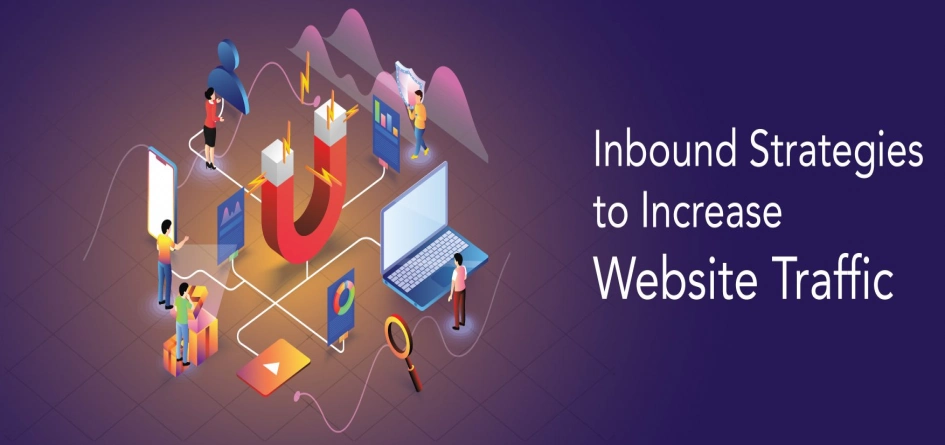

With almost all organisations having a website, it is imperative that one makes the most of it, in terms of getting traction. Having a visually appealing and mobile-friendly website is a given today, but without a robust strategy, you are not allowing it to reach its full potential and this could hamper your sales (we do not want that)! So, how do you make sure of that? Gone are the days of outbound or traditional marketing methods - today, brands are focusing on creating more reasons for customers to come to them - with an Inbound marketing strategy!
It’s actually a very straight methodology - attract prospects, convert them into customers, and have them stay with you, for good!
Feeling a bit overwhelmed? Do not fret, we are providing you with 10 powerful inbound marketing strategies that will boost your website traffic, pronto!
Content marketers across the world work tirelessly to make sure their content is hitting the right prospects, at the right stage of the conversion funnel. If you have not been focusing on blogs, start now! Create thorough buyer personas and on the basis of which, have each blog with relevant SEO keywords and customer questions in mind. Google keyword planner is a free tool that helps identify top keywords.
According to recent reports, only 69% marketers align their content with their sales and marketing funnel.
Whole Story, the blog of organic food retailer Whole Foods, is a great example of using their blog as means to explain their brand, values, and promote products to new and existing customers. By using catchy headlines, they make their blogs stand out and drive traffic.
So, whether you create new blogs or upcycle old ones - do it consistently, as this really helps you come across as a trusted source and authority in your field.
Moovly found that your website is 53% more likely to appear on Google’s first page results if it features a video. Transforming blog content into podcasts, videos, and e-books engages, educates, and builds trust with the customer; you also tap into an audience that does not have the time or prefers not to read through all content!
Good understanding of your target audience and creating appealing content is not enough strategy; it also needs to have a striking headline, multimedia elements, and a bit of storytelling.
A great example of this is Home Depot that consistently uses engaging videos on Facebook to get customers to visit their website. All of the videos have reference links that direct customers to their website and blog.

Optimizing keywords is one of the best inbound strategies today - infused with long-form content and long-tail keywords.
According to stats, the average conversion rate for long-tail keywords is a whopping 36%.
People actually use specific search terms; for example, “products for curly hair India” over “curly hair products.” To make their search meet the exact results, long-tail keywords which are 3-4 word keywords that are very specific to your product/service, do the trick. Find appropriate long-tail keywords by understanding what questions customers might be asking through the sales process. Include these in your title tags, headlines, and body text to start seeing increased website traffic.
As one of the most crucial factors in Google search rankings, backlinking is one of the oldest ways to increase website traffic, and it continues to be extremely effective. Links are an important part of how Google determines which website is a trusted source.
Sign up, reach out, and engage with users via forums, industry websites, and social media. Guest blogging also helps in generating backlinks. Keep reposting fresh content, videos, and infographics with reference links to your website. Backlinks might take more manual work, but they are worth the time and investment for delivering organic growth.
According to Statista, the number of global social media users is expected to reach 3.02 billion by 2021 (yikes!).
So, if you have created excellent content, then promote this content to generate more website traffic. As B2B inbound marketing your best weapon, you literally have billions of people waiting for you to give them what they are looking for!
And how do you utilise social media without spamming?
Easy, follow these tips:
According to Demand Gen Report, 87% of B2B buyers trust industry influencer content more.
This statistic is supported by the rise and success of social media marketing through influencers. Consumers are turning to Youtube Vloggers and influencers to receive information and recommendations because of trust; these influencers appear more genuine than cold calling marketers. However, aligning yourself with the right influencer is key.
Know your target audience, and network via Twitter, LinkedIn, and industry forums to identify top influencers. Use services like Followerwonk that allow you to search for influencers based on keywords.

H&M has started partnering with fashion influencers to launch their H&M studio collection. These carefully selected influencers promote the line on their personal handles and provide links that drive traffic back to H&M’s website
According to Social Marketing Writing, 62.96% people think that blogs with multiple authors are more credible.
An easy way to start building credibility and drive web traffic is by guest blogging yourself. You have created solid content, so don’t shy away from reaching out, giving your opinions on industry platform and social media, and writing for external blogs that have an active audience. Guest blogging also provides you the opportunity to create backlinks and cross links, and improved SEO that drives overall web traffic. Just like blogging for your own website, you need to guest blog consistently.
Webinars are a great way to drive traffic and also showcase your industry knowledge, which helps in building trust.
So, host webinars and keep them fun and creative; do not be afraid of using an informal, two-way discussion style webinar to engage customers. HubSpot’s webinar checklist can help you plan and execute one for yourself. Even if you host webinars on a different site, like YouTube, you can still include links that will direct the traffic back to your website.
The top 3 paid ad spots on a Google result page get 41% of the clicks on the page.

Paid search ads as yet another rock-solid way to driving website traffic, they offer immediate visibility as they appear on top of the search results (where you want to be). Include a call to action in the ad text, along with attractive headlines and landing pages to drive organic growth.
Do not forget email campaigns, as they are still the preferred form of communication and have massive ROI.
Include relevant links back to your website and content pages in your emails. Receiving an engaging email campaign from you, consistently, will not only drive traffic but also keep you fresh in the customer’s mind.
According to reports, $44.25 is the average ROI when it comes to email marketing spend for every $1.
So, start sending promotional emails to your target audience to ultimately convert them into customers.
Hope this blog gets you to start implementing some of these tools to increase traffic to your website. So, come on, leverage on your chic, mobile-optimised website by integrating these inbound marketing strategies and drive massive web traffic.
More traffic = More leads
More leads = More sales (yay!)
So, which inbound strategy appeals to you? Let us know in the comments below.
Want to start with Inbound Marketing? Get in touch with our Inbound Experts today!